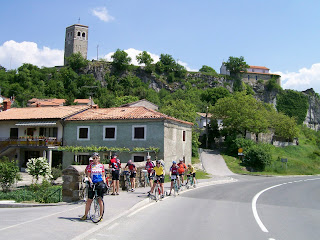Today we have a guest post from Adam York at Sublime Public Relations, www.sublimepub.com
Biking is fun, green, and good for your
health (an hour of moderate cycling burns about 600 calories). It’s also a
great way to absorb a destination slowly and without barriers. Bike tours are
becoming more and more popular worldwide and often organized around food, wine,
and other themes. While avid cyclists frequently represent bike vacationers,
regular travelers who are in decent shape can enjoy cycling tours, as
well.
Below are five cycling tours for all
skill levels that offer amazing access to exotic locales by bike.
 |
| Riding in Sardinia beside beautiful scenery. |
1. Mediterranean Island Hopping - Outdoor enthusiasts, photographers, and
nature and water lovers will be dazzled by the dramatic beauty of
Italian-influenced Sardinia and French-flavored Corsica as they tour these
fascinating Mediterranean islands by bicycle. This coastal route showcases
the best of northern Sardinia and western Corsica and their respective
Italian and French cultures. http://www.ciclismoclassico.com/trips/bike-tour-mediterranean/
 |
| History and beauty combined in a bike tour of Croatia. |
2. Croatia’s Istrian Peninsula - Italy’s neighbor to the East, Croatia
offers idyllic cycling through a medieval landscape of castles and
vineyards, all with a beautiful view of the Adriatic Sea. The terrain on
this peninsula’s coast is perfect for the cyclist who wants to combine
slightly rolling and hilly terrain with images of Croatia’s history and
unspoiled beauty. http://www.ciclismoclassico.com/trips/bike-tour-croatia-istrian-peninsula/
 |
| Spectacular mountain scenery on Going to the Sun road in Glacier National Park. Credit: The Cycling House |
 |
| Cycling in France gets you out of the city and into small villages. Credit: Hide & Seek |
 |
| Customize tours to your skill and interests when exploring Mediterranean islands. Credit: Ciclisima Classico |
5. Chile Wine Adventure - Explore the best of the Santiago valley region on this active wine and cuisine adventure. Enjoy biking through vineyards, trekking in the Andes, culinary tasting experiences and sightseeing on a week-long Chile tour. Visit well known museums and hidden gems as you soak in the beautiful landscapes and quaint villages which make this region unique and intriguing. Rides can customize and increase the biking distances for more advanced cyclists. http://www.adventure-life.com/tours/chile-wine-adventure-3335













































